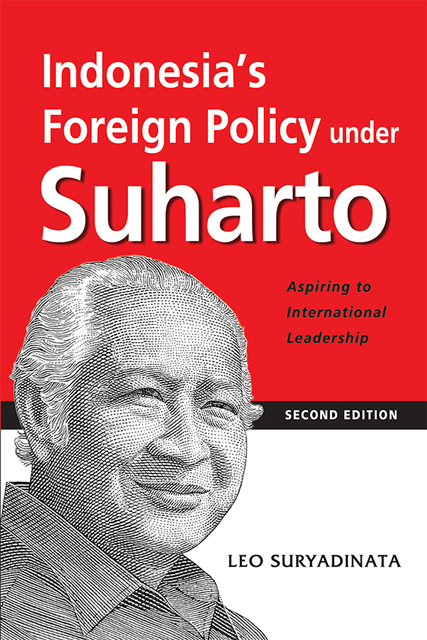Book contents
- Frontmatter
- Contents
- Preface to the Second Edition
- Preface
- Acknowledgements
- Introduction: Suharto’s Foreign Policy
- 1 Determinants of Indonesia’s Foreign Policy: In Search of an Explanation
- 2 Indonesia’s Foreign Policy before the New Order: In Search of a Format
- 3 Indonesia’s Foreign Policy during the “New Order” (I): The Rise of the Military
- 4 Indonesia’s Foreign Policy during the “New Order” (II): The Assertive Role of the President
- 5 Indonesia’s Relations with the ASEAN States: Regional Stability and Leadership Role
- 6 Indonesia’s Relations with Australia and Papua New Guinea: Security and Cultural Issues
- 7 Indonesia-China Relations: Ideology, Ethnic Chinese and the President
- 8 Indonesia-Vietnam Relations and the Kampuchean Issue: The Security Factor
- 9 Indonesia-Superpower Relations: Economic and Non-Economic Factors
- 10 Indonesia, the Middle East and Bosnia: Islam and Foreign Policy
- 11 Indonesia, the Non-Aligned Movement and APEC: In Search of a Leadership Role
- Conclusion: To Lead and Not to Be Led
- Postscript: Indonesia’s Foreign Policy from the Fall of Suharto to Joko Widodo: Still Aspiring to International Leadership?
- Bibliography
- Appendices
- Index
11 - Indonesia, the Non-Aligned Movement and APEC: In Search of a Leadership Role
Published online by Cambridge University Press: 01 September 2023
- Frontmatter
- Contents
- Preface to the Second Edition
- Preface
- Acknowledgements
- Introduction: Suharto’s Foreign Policy
- 1 Determinants of Indonesia’s Foreign Policy: In Search of an Explanation
- 2 Indonesia’s Foreign Policy before the New Order: In Search of a Format
- 3 Indonesia’s Foreign Policy during the “New Order” (I): The Rise of the Military
- 4 Indonesia’s Foreign Policy during the “New Order” (II): The Assertive Role of the President
- 5 Indonesia’s Relations with the ASEAN States: Regional Stability and Leadership Role
- 6 Indonesia’s Relations with Australia and Papua New Guinea: Security and Cultural Issues
- 7 Indonesia-China Relations: Ideology, Ethnic Chinese and the President
- 8 Indonesia-Vietnam Relations and the Kampuchean Issue: The Security Factor
- 9 Indonesia-Superpower Relations: Economic and Non-Economic Factors
- 10 Indonesia, the Middle East and Bosnia: Islam and Foreign Policy
- 11 Indonesia, the Non-Aligned Movement and APEC: In Search of a Leadership Role
- Conclusion: To Lead and Not to Be Led
- Postscript: Indonesia’s Foreign Policy from the Fall of Suharto to Joko Widodo: Still Aspiring to International Leadership?
- Bibliography
- Appendices
- Index
Summary
Introduction
This chapter examines Indonesia’s role in the Non-Aligned Movement (NAM) and Asia-Pacific Economic Co-operation (APEC) Forum. In the first part, the following questions on NAM are asked: How important is NAM to Suharto’s Indonesia? Why has Indonesia been interested in becoming the Chairman of the NAM conference? What has been done by Indonesian leaders to achieve this objective? Have they been successful? In the second part, another set of questions are posed: What has been the importance of APEC to Suharto’s Indonesia? Why did Suharto change his mind on APEC? Was it for economic reasons or political reasons, or both? Is it the way for Suharto to project Indonesia’s international leadership position?
The Non-Aligned Movement
Origins of NAM
Indonesia perceives itself as one of the founders of the Non-Aligned Movement, and it wants to be recognized as such. Not surprisingly, Indonesia has tried very hard in recent years to secure the chairmanship of the NAM conference.
In most Indonesian publications on the subject of Indonesian foreign policy, the Non-Aligned Movement has been considered to have originated at the 1955 Afro-Asian Conference, also known as the Bandung Conference. The Bandung Principles, or Dasasila Bandung, are believed to be the basis of the NAM principles. In fact, the first conference of the Non-Aligned Movement was held in 1961 in Belgrade, Yugoslavia. Josip Broz Tito of Yugoslavia, Jawaharlal Nehru of India, and Abdul Nasser of Egypt are always linked with the Movement and the countries that they represented have, in turn, chaired the Movement. Indonesia was always left out.
The first Conference of the Non-Aligned Movement was attended by 28 countries which had expressed concern over tensions in the international arena, especially relations between the two superpowers. The conference participants wished the superpowers to refrain from using military means to solve their differences and stated that they did not wish to be aligned with either superpower. The non-aligned countries would be willing to work with any country to achieve world peace. Although Indonesia was one of the participants in this conference, its role was not conspicuous.
The second NAM Conference was held in Cairo in 1964. At this conference, there was a conflict of interest between India and Indonesia. India was in favour of peaceful co-existence of countries with different political systems while Indonesia advocated confrontation between the New Emerging Forces (Nefos) and the Old Established Forces (Oldefos).
- Type
- Chapter
- Information
- Indonesia's Foreign Policy under SuhartoAspiring to International Leadership, pp. 172 - 185Publisher: ISEAS–Yusof Ishak InstituteFirst published in: 2023



